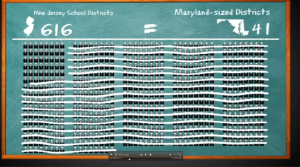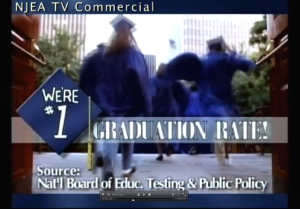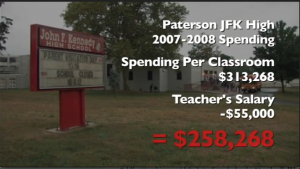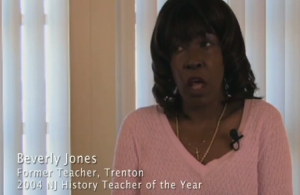In The Cartel, Bowdon highlights common misconceptions that people have based on misinformation about the education system, promotes the concept that an increase in the number of schools available will increase competition and create better schools, and reveals the corruption that exists within the public school system that allows for the country that spends the most on education to be the country with the lowest academically performing students in the world. Bowdon utilizes a Friedman framework to supposedly better enable disenfranchised students by giving them more school choices, however he seems to completely miss the point for why the students/parents are choosing these alternative schools. It is not for the love of a “better school,” but rather for the love of a safer school.
In this documentary, Bowdon highlights critical problems that exist within the public school system which he identifies as “inherent structures” reflective of a “monopoly model” that is rampant nationwide to the grave disadvantage of the children. He identifies one monopoly that does indeed exist, and rather than address what can be done to the betterment of all children or even what the true underlying problems of all the existing structures that have influenced the educational system, he advocates for another monopoly system, because the children are not the crux of his issue, it’s money. So he promotes school choice within a Milton Friedman framework of free market autonomy that reduces education to a product which can be bought and sold. This effort, this movement, to consumerize and commercialize education to match market demands which views parents as clientele, and efficiency and competition as hallmarks of success is not only disastrous for the educational realities of the children this system purports to be supporting, but is actually apathetic to their struggle and all of the context that engulfs them on a daily basis to either succeed or fail in spite of themselves. Because fundamentally Bowdon is most concerned with a monopoly that does act as a disservice to most children in this country, however not because of the inherent injustice of what that disservice represents, but rather because of the money that is “lost” or wasted as a result of that disservice. Money that is wasted, depending on who you are talking to (since there are individuals that are gaining that money), and money that is also used as power by the force of the teachers’ unions to protect the interest of the teachers, so they say. But most importantly, money that belongs to whom? Money that belongs to him actually, as a resident of New Jersey, and all of his fellow tax paying stateswomen/men. So, really, he’s concerned with what’s happening with his money, not what’s happening to these children, and is manipulating their very real strife to his own economic, and even sociopolitical advantage (in an effort to also gain some power for himself and his “cause”). However, none of this is in regards to the children. Again, those precious minds whose very minds are being used as pawns to further everyone else’s agenda (whether pro school choice or anti school choice), but never actually being considered worthy in of themselves, only to the extent of how they can be monopolized to promote some other agenda, thus being forced to justify their own existence. And not all precious minds, but the minds of those children in the lower socio-economic branch of our society. Because if this was all really about the children, providing the best “public” education system for the children, if this was really a documentary about trying to understand what is going wrong in the public education systems that exist within these neighborhoods, with how the teacher’s union operates within these neighborhoods, than why not explore positive public education systems in other neighborhoods and how the teachers unions operate there? Why not identify a problem, that is obviously an economic issue, but then see how/if at all these same economic issues exist in public education systems in other neighborhoods and how such problems were addressed? In neighborhoods where public schools flourish and success is even normative. Thus, being forced to examine the underlying, insidious, disastrous, cyclical, systematic oppressive forces that exist to the detriment of these children educationally and otherwise. Thus, being forced to recognize different ways that tracking systems do exist still within these neighborhoods to ensure that some students never succeed and are filtered into a life of crime (petty and otherwise) in an effort to either fill prisons or the military, both of which are industries that have also been corporatized and privatized (although the choice is not for the prisoner/soldier “consumer” but the corporate-fueled producer). So of course, neo-conservative individuals, publications, news outlets, etc. support this movie, and ultimately support decentralization and the school-choice movement, which conveniently does not consider the lasting and continuous effects of privilege, racial and otherwise.
Despite his very journalistic and fact-heavy approach to this documentary, using both pathos and enough ethos to both educate and move the audience, the taxpayers, even Bowdon acknowledges, if only for a moment, that what is at the heart of the educational plight of children in urban environments. Hope Academy is a charter school that is not comparatively exemplary to local public schools statistically, according to test scores, and other quantitative measures. Yet, the students who attend, do not only continue to choose Hope Academy, they feel it is their salvation in many ways. Not for the better quantity education, but rather for the better quality education. A quality that cannot be measured and quantified, but does have scientific support and does indeed yield positive results over time. A high-stress environment, including actual or the threat of physical, sexual, psychological, or emotional violence is not conducive to learning, especially concerning the first six years of life, the early formative years of cognitive development. School becomes a place one must survive physical, emotional, psychological, or sexual harm, and the consequential development of maladaptive behaviors is a normal response to an abnormal situation. So, the parents who are either beyond elation, or devastatingly crushed when it comes time for the lottery are not happy or upset that their child is going to have better test scores. Whether it’s a lottery for a charter school, private school, voucher school, or just another public school in a better neighborhood, these parents recognize the opportunities that such places can provide for the kind of person their child can become, not just the kind of student they can become. They realize that they can indeed, have a chance.
But such relief should not be seen as only possible in the consumerized and commercialized market world of the school choice movement, it should be inherent within the public school system. Education is not a random birthright privilege for some, and a random numerical privilege for those who are willing to fight for it. Because the right to learn within a safe environment is a basic human right that should not be trivialized to a product that can be negotiated and manipulated. And it is the responsibility, as well as the economic advantage, of our government to provide such an education system for all of it’s children.
Bibliography:
Olin, Andy. “Director wants to school viewers on the public education system.” Chron. April 23, 2010. Retrieved, March 1, 2014, from http://blog.chron.com/peep/2010/04/director-wants-to-school-viewers-on-the-public-education-system/.
Orange, Michelle. “Documenting Our Crooked Educational System in The Cartel.” New York Village Voice. Apreil 13, 2010. Retrieved, March 1, 2014, from http://www.villagevoice.com/2010-04-13/film/documenting-our-crook-educational-system-in-the-cartel/.
“The Cartel.” http://www.thecartelmovie.com/cgi-local/content.cgi?g=23.
Bowdon, Bob. The Cartel. 2009. Film
Ravitch, Diane. The Death and Life of the Great American School System: How Testing and Choice Are Undermining Education. New York: Basic Books, 2010.
Alexander, Michele. The New Jim Crow. New York: The New Press, 2010.






